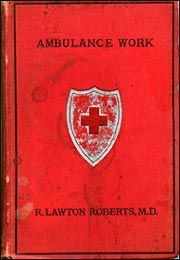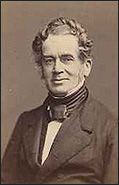|
Ambulance Work by R. Lawton Roberts, MD |
I collect books. Primarily, I collect first edition books by Mark Twain (not an inexpensive endeavor, mind you). I also collect a fair number of old medical books — especially those that pertain to emergency care. The oldest EMS book I own is called Ambulance Work. It was written by R. Lawton Roberts, MD, and was published in 1891. In regard to the treatment of shock, it states:
“When a man is suffering from shock he is depressed, so you should speak kindly to him, try to cheer him up, and give what encouragement you can. He is faint, so you should place him in a lying down position — flat on his back.”
However, during World War I it became common practice to place the shock patient in the Trendelenburg position — lying supine with the feet elevated. This was thought to move blood from the lower extremities to the body core. What was the science, if any, behind this change in treatment?
The Trendelenburg position was described by German surgeon Friedrich Trendelenburg (1844-1924) in 1873. The position was commonly used in pelvic surgery as gravity pulled the
|
Friedrich Trendelenburg, a German surgeon |
abdominal organs up from the operative field, thus improving visibility. Trendelenburg postulated that such a position would help return blood from the lower extremities to the trunk and would be beneficial in shock. Thus, without scientific evidence, the practice was adopted — primarily because of Trendelenburg’s highly regarded standing as a surgeon. By the end of the 19th century, it was widely used on both sides of the Atlantic.
In 1967, Los Angeles researchers evaluated the Trendelenburg position and found that it did not provide any benefit in improving circulation during clinical shock. British researchers evaluated the effectiveness of the Trendelenburg position on both hypotensive and normotensive patients. The study included 76 patients—15 of whom were in shock (systolic BP < 70 mmHg). A Swan-Ganz catheter and a radial artery catheter were inserted. The patients were then tilted in a 10-20 degree head-down position for 3-5 minutes and physiologic parameters were measured. They concluded, “Our study failed to document any consistent beneficial or detrimental effect of Trendelenburg positioning in acutely ill normo- or hypotensive patients.”
In 1985, Herbert Bivins performed a study of 10 healthy volunteers in which he tagged red blood cells with a radioisotope and measured the actual amount of blood that moved with application of the Trendelenburg position. He found that only 1.8 percent of the patient’s total blood volume was displaced. Interestingly, Bivins did a similar study on the MAST/PASG where, using the same technique, he demonstrated that the amount of blood autotransfused following application of the MAST/PASG was minimal.
Sing and colleagues evaluated the effectiveness of oxygen transport in hypovolemic patients following application of the Trendelenburg position. They found “the increase in blood pressure for Trendelenburg position is not associated with an improvement in blood flow or tissue oxygenation.” Japanese researchers found a small benefit to tilting 10 degrees in 10 healthy adult volunteers. However, these effects diminished after 10 minutes.
In summary, there is no evidence that use of the Trendelenburg helps in shock. Although there is no evidence of harm reported in the literature, all studies were not in the prehospital setting. In the prehospital setting, we must assume that spinal injury is a possibility in trauma. Moving a patient into the Trendelenburg position (unless the patient is on a back board or stretcher and the whole backboard or stretcher is tilted) may exacerbate a spinal injury. Most important, if it does not make a difference, why do it? Overall, the Trendelenburg position provides little, if any, benefit for the patient and probably should not be used.
As we have seen numerous times in the evolving field of EMS, beliefs and practices go full circle. Such is the case with the Trendelenburg position. The antique book Ambulance Work is more accurate, in this regard, than the EMS books of today. In EMS, we might often be better off embracing the philosophy of Occam’s razor, based on the medieval philosophy of nominalism. It states, “When confronted with two plausible theories for an event, choose the simplest one with the fewest assumptions.”
References
- Roberts RL. Ambulance Work, Fourth Edition with Illustrations. London: H.K. Lewis, 1891
- Martin JT. The Trendelenburg position: A review of the current slants about head down tilt. Journal of the American Association of Nurse Anesthetists. 1995;63:29-36.
- Taylor J, Weil MH. Failure of the Trendelenburg position to improve circulation during clinical shock. Surgery, Gynecology and Obstetrics. 1967; 124:1005-1010
- Sibbald WJ, Patterson NAM, Holliday RL, Baskerville J. The Trendelenburg position: hemodynamic effects in hypotensive and normotensive patients. Critical Care Medicine. 1979;7:218-224
- Bivins HG, Knopp R, De los Santos PA, Blood volume distribution in the Trendelenburg position. Annals of Emergency Medicine. 1985;14:641-643
- Bivins HG, Knopp R, Tiernan C, dos Santos PA, Kallsen G. Annals of Emergency Medicine1982;11(8):409-12
- SingRF, O’Hara D, Sawyer MAJ, Marino PL. Trendelenburg position and oxygen transport in hypotensive adults. Annals of Emergency Medicine 1994;23:564-567
- Terai C, Anada H, Matsushima S, et al. Effects of mild Trendelenburg on central hemodynamics and internal jugular vein velocity, cross –sectional area, and flow. American Journal of Emergency Medicine. 1995;13:255-258.














